Family Lunch Meal Prep Ideas For Multiple Lunchboxes
Discover practical family lunch meal prep ideas for multiple lunchboxes. Get simple, stress-free meal planning tips and recipes to save time and satisfy your family’s taste buds.
What if packing lunches didn’t have to feel like a daily scramble? As a chef and parent in Asheville, I’ve learned that smart kitchen systems beat perfection every time. Let’s turn chaotic mornings into smooth routines with strategies that work for real life – sticky fingers, tight budgets, and all.
This guide shares my favorite prep-ahead methods for creating nourishing dishes that keep everyone fueled. We’ll explore batch cooking tricks, flavor-packed combinations, and storage hacks developed through years of testing (and occasional burnt casseroles). Whether you’re feeding picky eaters or balancing work demands, these solutions adapt to your unique rhythm.
- Transform meal planning into a simple system that grows with your schedule
- Use pro kitchen techniques adapted for home cooks with limited time
What Family Lunch Meal Prep Is All About
Imagine opening your fridge to find ready-to-go containers that keep everyone satisfied from sunrise to sunset. That’s the magic of strategic prepping – turning kitchen time into fuel for your week rather than a daily chore. During my early days as a working parent, I discovered that organized food prep wasn’t about fancy recipes, but smart systems that adapt to real life.
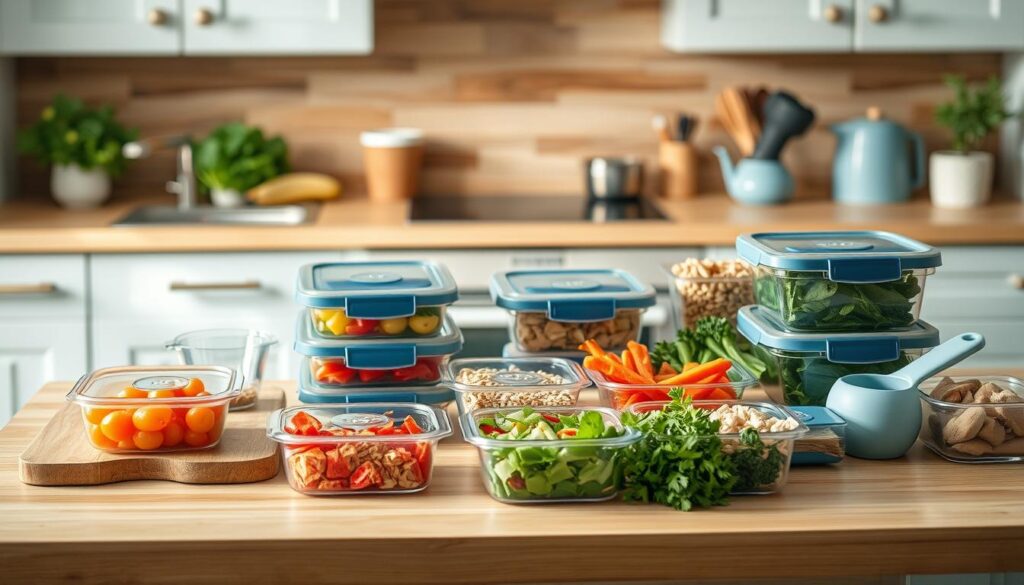
Kitchen Confidence for Modern Schedules
Batch cooking transformed my mornings from chaotic scrambles to smooth routines. By dedicating 90 minutes weekly to meal prep basics, I create building blocks like roasted veggies and marinated proteins. These become customizable bowls, wraps, or salads that even picky eaters enjoy.
Beyond the Lunchbox
The true power lies in cross-utilizing ingredients. Overnight oats prepped for breakfast double as afternoon snacks, while grilled chicken from dinner becomes tomorrow’s Caesar salad. This approach cuts grocery costs and decision fatigue – two major stressors for busy households.
Recent surveys show 68% of Americans now incorporate some form of food prepping, with grab-and-go options like chia puddings gaining popularity. Why? Because they deliver nutrition without the morning madness. My goal is to help you develop your own rhythm, using techniques that fit your unique schedule and taste preferences.
Getting Started with Weekly Meal Prepping
Think of your kitchen as a weekend project that fuels your week. My system begins with two non-negotiables: a 30-minute planning session and strategic tool selection. Through trial and error (like the time I prepped 12 identical salads nobody touched), I discovered success lies in flexibility over rigidity.

Planning Your Menu and Components
Start with a whiteboard or notebook. Jot down three elements: 1) Protein anchors (grilled chicken, beans), 2) Versatile carbs (quinoa, whole-grain wraps), 3) Crunchy veggies (bell peppers, snap peas).
“Your plan should have 50% crowd-pleasers and 50% new flavors to keep things interesting,”
I tell clients. Batch-roast vegetables while cooking grains – multitasking saves hours.
Overnight oats became my secret weapon. Mix rolled oats with milk, chia seeds, and frozen berries in jars. They’re ready by morning and adaptable – add nut butter for extra protein or cocoa powder for chocolate lovers.
Essential Kitchen Tools and Containers
Invest in three workhorses:
- A sharp chef’s knife (Victorinox Fibrox Pro works great)
- Two rimmed sheet pans for roasting
- 1-gallon zip bags for marinating proteins
For storage, glass containers with snap lids prevent leaks. I prefer rectangular shapes – they stack neatly and fit more portions. Pro tip: Use small reusable cups inside containers to keep dressings separate until serving.
Remember, your first attempt won’t be Pinterest-worthy. Focus on functionality. Did everyone get fed? Did you save time? That’s what truly matters.
Creative Family Lunch Meal Prep Ideas
Ever stared into the fridge wondering how to please everyone? The answer lies in flexible recipes that transform basic components into crave-worthy combinations. Let’s explore kitchen-tested formulas that adapt to different preferences while keeping your prep time minimal.
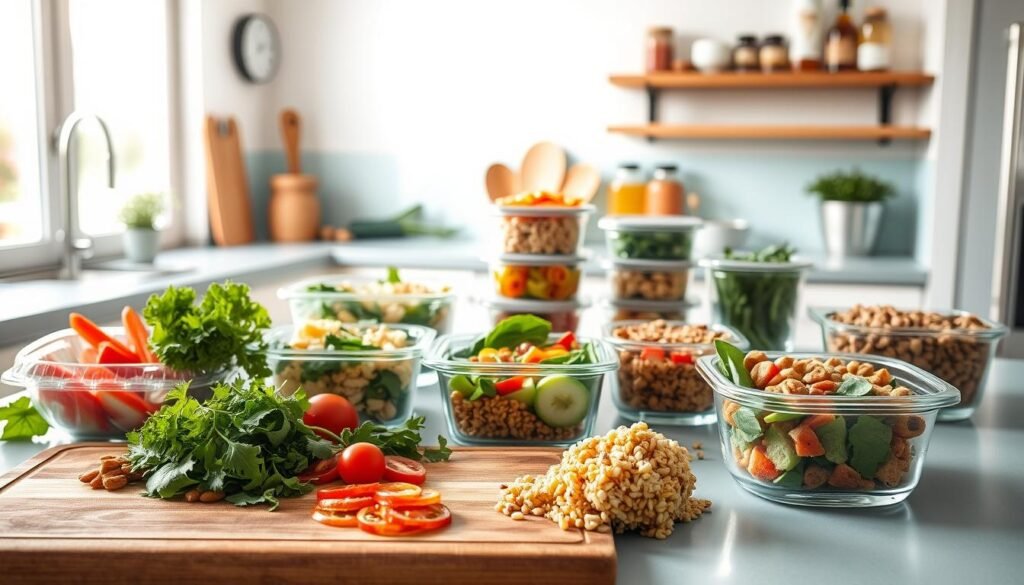
Simple Recipes to Satisfy Every Palate
Start with Mediterranean quinoa salad – a perfect canvas for customization. Mix pre-cooked quinoa with cherry tomatoes, cucumber, and olives. For protein lovers, add chickpeas or leftover grilled chicken. Dairy-free? Skip the feta. This dish improves in the fridge, making it ideal for make-ahead planning.
Overnight oats shine when layered with textures. Combine rolled oats, almond milk, and chia seeds as your base. Let family members top theirs with preferred mix-ins: cinnamon apples for some, dark chocolate chips for others. It’s breakfast and snack prep done simultaneously.
Boost flavors without complexity. Whip up a zesty lemon-tahini dressing using pantry staples: 3 parts olive oil, 1 part lemon juice, 1 spoon tahini. Drizzle over roasted veggies or grain bowls. As one parent told me, “This sauce made my kids actually eat Brussels sprouts!”
Remember: successful cooking relies on versatile foundations. Batch-cook three components weekly – grains, proteins, chopped veggies – then remix them into wraps, salads, or stir-fries. Your future self will thank you when Wednesday’s lunch comes together in 5 minutes flat.
Creative Lunchbox Ideas for the Entire Week
Transform midday fuel stops into moments of delight with building blocks prepped during quieter moments. My test kitchen swears by these two rules: 1) Prep components separately for maximum flexibility 2) Let texture and color guide your combinations.
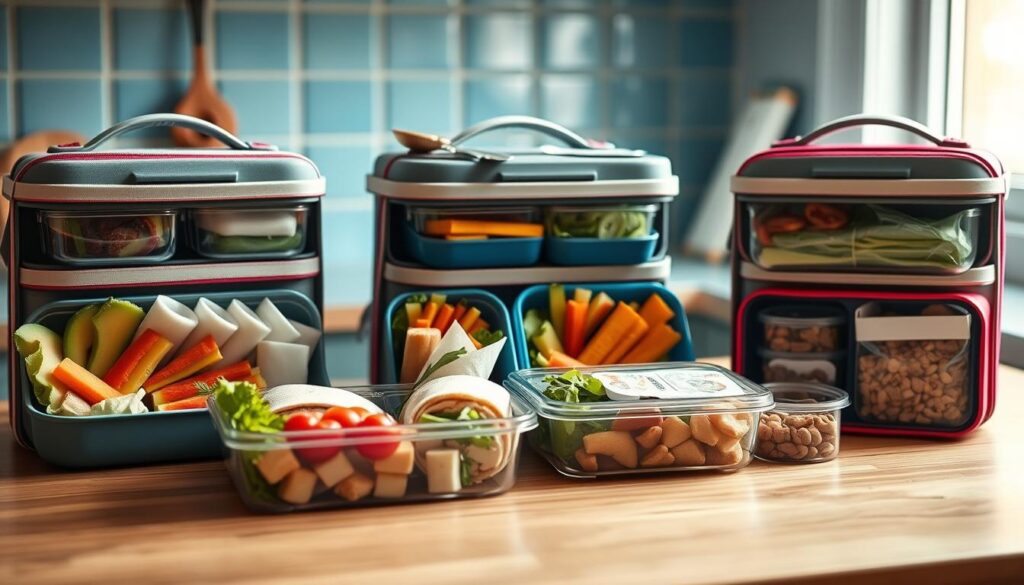
Sandwiches, Wraps, and Pinwheel Variations
Sunday’s roasted turkey becomes Monday’s wrap and Wednesday’s pinwheels. Slice proteins thin and store with parchment between layers. For wraps, spread hummus first – it acts as a moisture barrier. A parent recently shared:
“My kids now request ‘sushi sandwiches’ – turkey and avocado rolled in nori sheets!”
Mix textures to combat soggy bread syndrome. Keep dressings in tiny containers and add crunchy elements like radish slices or toasted nuts last-minute. Try these combos:
- Curried chicken salad with apple matchsticks
- Roasted veggie & goat cheese pinwheels
Bento-Style Lunchbox Inspirations
Think edible rainbows rather than perfect portions. Divide containers into quadrants: protein stars (hard-boiled eggs), crunchy players (sugar snap peas), sweet notes (berries), and wild cards (dark chocolate squares).
Use silicone cupcake liners to separate ingredients without extra dishes. For picky eaters, include 1 familiar item + 1 new flavor. Pair with a simple side like citrus-dressed kale or cucumber ribbons – they stay crisp for days when stored properly.
Nutritious Salads and Bowl Meal Prep Recipes
Ever wish your fridge could do the lunch prep for you? Vibrant salads and grain bowls solve the midday fuel puzzle with minimal effort. The key lies in building layers of texture and flavor that hold up for days – no sad, soggy greens here.
Mediterranean Quinoa Salad and Other Grain Salads
My go-to quinoa salad combines 2 cups cooked quinoa with cherry tomatoes, cucumber, and kalamata olives. Add chickpeas for plant-based protein or feta for tang. Pro tip: Toss ingredients with dressing just before serving to maintain crunch.
Grain salads thrive on these elements:
| Base | Protein | Crunch Factor | Dressing |
|---|---|---|---|
| Farro | Grilled shrimp | Toasted almonds | Lemon-herb vinaigrette |
| Brown rice | Black beans | Jicama sticks | Cilantro-lime crema |
Fresh Veggie and Protein-Packed Bowls
Build better bowls with this formula: 1/2 cup grains + 1 protein + 2 veggies + sauce. Roast sweet potatoes and broccoli together on Sunday. Store components separately for mix-and-match flexibility.
A parent recently shared:
“My kids now eat 3x more veggies when they get to build their own bowls!”
Keep dressings in small jars for last-minute drizzling. Try my 3-minute tahini sauce: mix 1/4 cup tahini with lemon juice, garlic powder, and water until pourable. It transforms basic ingredients into crave-worthy combinations.
Easy Protein-Packed Options and Kid-Friendly Favorites
What if one cooking session could fuel your week with tasty proteins everyone loves? Building a protein toolkit solves two challenges: keeping energy levels steady and pleasing varied taste buds. My kitchen thrives on versatile staples that work in wraps, salads, or eaten straight from the container.
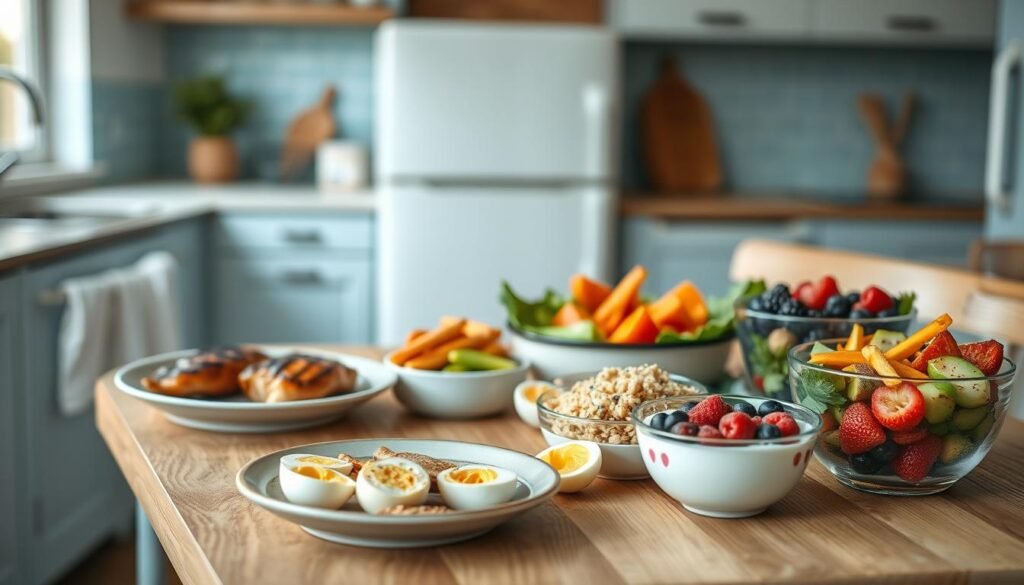
Egg Salad, Chickpea Salad, and More
Hard-boiled eggs become heroes when transformed into a creamy salad. Mash 6 eggs with Greek yogurt, mustard, and diced celery for crunch. A parent recently shared:
“My kids call it ‘dippy eggs’ – they spread it on crackers or celery sticks!”
Chickpea salad offers plant-powered flexibility. Combine 2 cans rinsed chickpeas with lemon juice, olive oil, and smoked paprika. Let it marinate overnight – the flavors deepen while staying fridge-ready for 4 days. Serve in pitas or over greens.
| Protein | Prep Time | Kid-Friendly Twist |
|---|---|---|
| Egg Salad | 15 mins | Add shredded carrots for color |
| Chickpea Salad | 10 mins | Mix in diced apples |
Grilled and Slow-Cooked Protein Ideas
Sunday’s grilled chicken breasts become Monday’s wraps and Wednesday’s stir-fry. Marinate in zesty Italian dressing overnight, then grill 6-8 breasts at once. Slice some for salads, shred others for tacos.
Slow-cooker pulled pork saves busy days. Rub a 3-lb shoulder with cumin and garlic powder, cook on low 8 hours. Portion into freezer bags – it reheats perfectly for nachos, sandwiches, or rice bowls.
Three rules for protein success:
- Cook once, use three ways
- Season simply to maximize versatility
- Store in ½-cup portions for easy grabbing
Optimizing Ingredients and Utilizing Leftovers
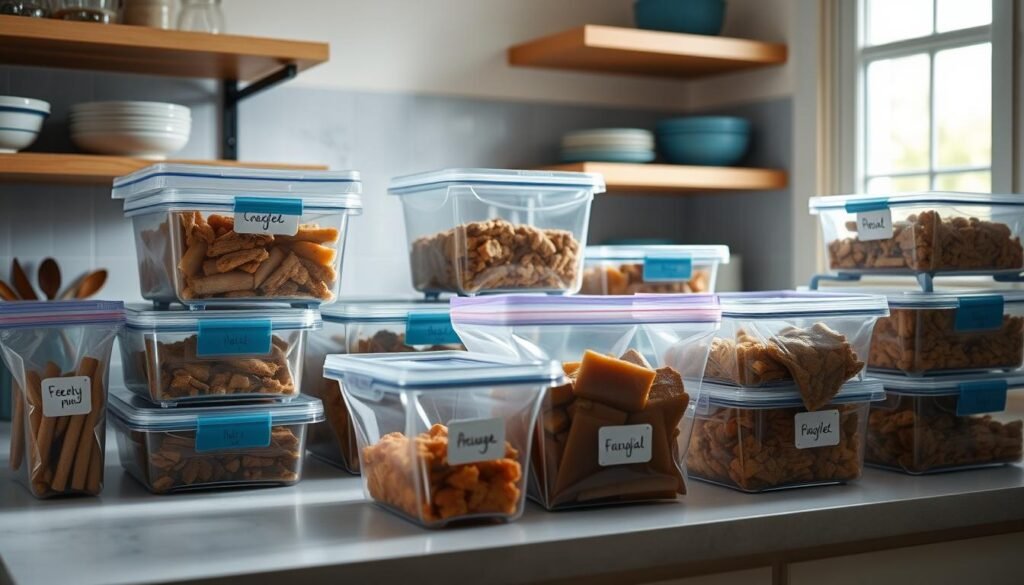
Your freezer could be the unsung hero of your kitchen routine. During my years cooking in Asheville restaurants, I learned that smart ingredient management trumps daily cooking marathons every time. Let’s turn “What’s for dinner?” into “Which delicious option should I thaw?”
Batch Cooking and Freezer Storage Tips
Big batch cooking starts with strategic choices. Double recipes for soups, stews, and roasted vegetables – they freeze beautifully. A parent recently shared:
“Making eight servings of chili instead of four gave me three ready-made meals for later weeks!”
Freeze smarter with these guidelines:
| Food | Prep Method | Storage Time |
|---|---|---|
| Cooked beans | Portion in 1-cup bags | 3 months |
| Roasted veggies | Spread flat on parchment | 2 months |
| Marinated proteins | Vacuum-sealed packs | 6 months |
Quality containers make all the difference. Use freezer-safe glass or BPA-free plastic. Label everything with dates – frozen pesto from July still tastes fresh in October when stored properly.
Sunday reset sessions transform weekly stress. Cook two foundation dishes (like quinoa and shredded chicken) while prepping three freezer-friendly items. This creates mix-and-match potential for fast meals. Pro tip: Freeze sauces in ice cube trays for instant flavor boosts.
Remember: Your future self will thank you when Wednesday’s dinner is just a thaw away. Start small – even one extra portion frozen weekly builds a safety net over time.
Incorporating International Flavors and Creative Dressings
Your sauce collection could be the passport that transforms basic ingredients into global adventures. During my years cooking in Asheville’s diverse food scene, I discovered that bold flavors thrive in make-ahead recipes. A well-crafted dressing or marinade breathes new life into prepped proteins and grains.
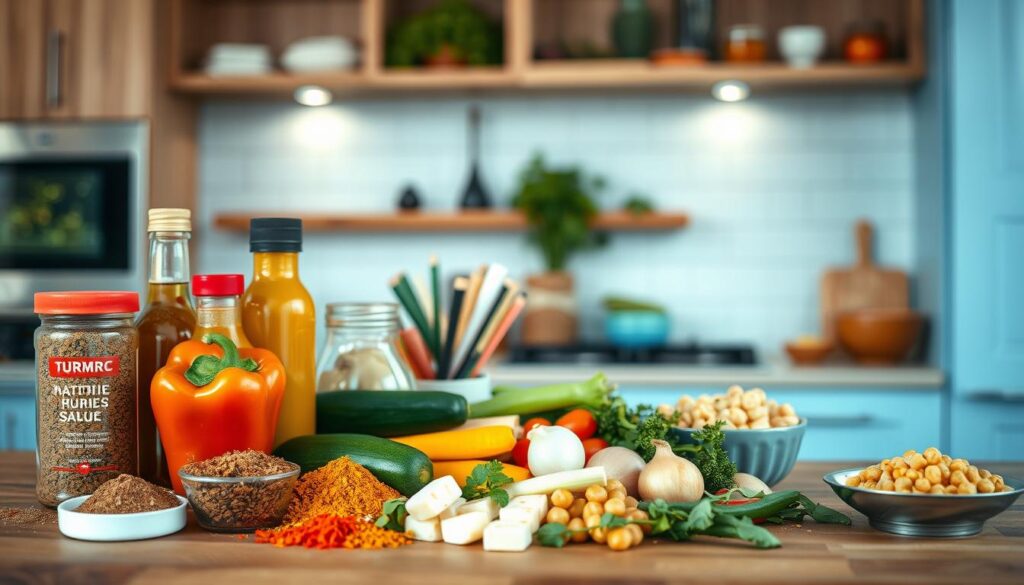
Homemade Sauces and Marinades
Three versatile bases anchor my flavor toolkit:
- Tahini-lemon drizzle (Middle Eastern)
- Peanut-lime sauce (Southeast Asian)
- Green goddess blend (French-American)
Whip up these in minutes using pantry staples. A parent recently shared:
“The peanut sauce made our chicken skewers taste like takeout – but healthier!”
Global Flavor Inspirations
Rotate regional profiles to keep taste buds engaged. Try these combinations:
| Cuisine | Spice Blend | Pair With |
|---|---|---|
| Mexican | Cumin + smoked paprika | Black beans, roasted corn |
| Thai | Lemongrass + ginger | Shrimp, rice noodles |
| Mediterranean | Oregano + sumac | Chickpeas, grilled zucchini |
Marinate proteins overnight in these blends for depth. Store sauces in squeeze bottles – they stay fresh 5 days and make assembly effortless. Try this trick: freeze herb pastes in ice cube trays for instant flavor boosts.
Remember, exploration trumps perfection. Start with one new sauce weekly. Your kitchen experiments might just become next month’s favorites.
Organizing Your Meal Prep with Smart Containers
The right container can turn kitchen chaos into calm. After years of testing options in my Asheville kitchen, I’ve learned that smart storage isn’t about aesthetics – it’s about preserving flavors and saving precious minutes during busy mornings.
Choosing the Right Containers for Freshness
Quality containers protect your efforts. Glass options like Pyrex prevent odor transfer and handle oven reheating. Plastic choices work for lightweight needs – look for BPA-free labels. Ceramic dishes shine for presentation but weigh down lunch bags.
| Material | Best For | Lifespan |
|---|---|---|
| Glass | Sauces, roasted veggies | 5+ years |
| Plastic | Snacks, dry goods | 2-3 years |
| Stainless Steel | On-the-go meals | 10+ years |
Maximize fridge space with these tricks:
- Stack rectangular containers vertically
- Use clear bins for small items like dressings
- Label lids with prep dates using washable markers
A parent recently shared:
“Switching to divided containers helped my kids actually eat their veggies – no more flavor mixing!”
For nut-free needs, choose containers with tight seals. Compartmentalized designs keep pasta salads crisp by separating dressings. Remember: Your storage system should work as hard as you do in the kitchen.
Family-Approved Snacks and Sides to Complement Lunches
What if snack time could be as effortless as opening your pantry? After years of testing recipes with picky eaters (including my nephew who once ate only white foods), I’ve discovered smart solutions that balance nutrition with kid-approved flavors. The secret lies in prep-friendly options that work equally well as sides or standalone bites.
Veggie Muffins, Fresh Fruit, and Dips
Savory zucchini-carrot muffins became my sneaky veggie vehicle. Mix 1 cup shredded veggies with whole wheat flour, eggs, and shredded cheese. Bake in silicone cups for portion control. A parent recently confessed:
“My kids think they’re eating cupcakes – I don’t correct them!”
Pair with colorful dippers using this formula:
- Crunch: Sugar snap peas, bell pepper strips
- Sweet: Apple slices, pineapple chunks
- Dip: Greek yogurt ranch or sunflower seed butter
Prep smarter with these batch tips:
| Snack | Prep Time | Storage |
|---|---|---|
| Veggie muffins | 25 mins | Freeze 3 months |
| Fruit cups | 10 mins | Fridge 5 days |
| Hummus | 5 mins | Fridge 1 week |
Portion dips in 2-oz containers for grab-and-go convenience. Mix leftover roasted chicken into muffin batter for protein boosts. These sides transform basic lunches into vibrant spreads without extra morning effort.
Balancing Nutrition with Tasty Flavors in Daily Meal Prep
What if every bite could nourish your body and excite your taste buds? In my Asheville test kitchen, I’ve found the sweet spot between health and flavor lies in strategic combinations. Let’s explore how to craft meals that leave everyone energized and asking for seconds.
The Art of Harmonious Plates
Successful dishes balance three elements: fuel (proteins), foundation (carbs), and freshness (greens). Try this formula:
| Energy Boosters | Sustaining Bases | Vibrant Accents |
|---|---|---|
| Grilled tofu | Wild rice | Massaged kale |
| Shredded chicken | Quinoa | Shaved Brussels sprouts |
A parent recently shared:
“Using this trio method cut our snack cravings in half – meals actually keep us full now!”
Portion control becomes effortless with divided containers. Fill 1/3 with roasted sweet potatoes, 1/3 with lemon-herb chicken, and 1/3 with broccoli slaw. The visual balance naturally creates nutritional harmony.
Smart pairing elevates satisfaction. Try these combos:
- Tangy Greek yogurt with breakfast berries becomes lunch’s veggie dip
- Morning smoothie leftovers transform into afternoon chia pudding
Storage matters as much as prep. Keep dressings separate until serving time. Line containers with parchment paper to prevent sogginess – roasted veggies stay crisp for three days this way.
Your perfect mix might take practice. Start with one new combination weekly. Rotate proteins and grains while keeping favorite veggies constant. Remember: Nutrition thrives on variety, not perfection.
Mastering meal prep turns daily chaos into calm – one roasted veggie batch at a time. Through years of testing in my Asheville kitchen, I’ve seen how simple systems create more space for what matters: shared moments, not morning scrambles.
Start with what works today. Maybe it’s prepping overnight oats every Sunday or stocking divided containers for easy assembly. These small wins build confidence. Remember those grilled chicken breasts we discussed? They’re proof that foundational ingredients fuel endless combinations.
Your journey might look different than mine – and that’s perfect. One parent’s grain bowl masterpiece could be another’s trail mix triumph. What unites us? The relief of opening a fridge full of ready-to-go options that keep everyone energized.
Progress beats perfection every time. Try one new prep idea this week, whether it’s freezer-friendly sauces or snack-packed bento boxes. Notice how even modest planning creates ripple effects: less decision fatigue, more time for afternoon adventures.
Every container prepped is a victory lap around yesterday’s stress. Keep tweaking, keep tasting, and most importantly – keep celebrating those small steps toward kitchen confidence.
Mini Veggie Pita Pizzas with Herbed Yogurt Drizzle
These mini veggie pita pizzas are a delightful and healthy twist on traditional pizza. Topped with a medley of fresh vegetables and finished with a tangy herbed yogurt drizzle, they're perfect for a light lunch or a fun appetizer.
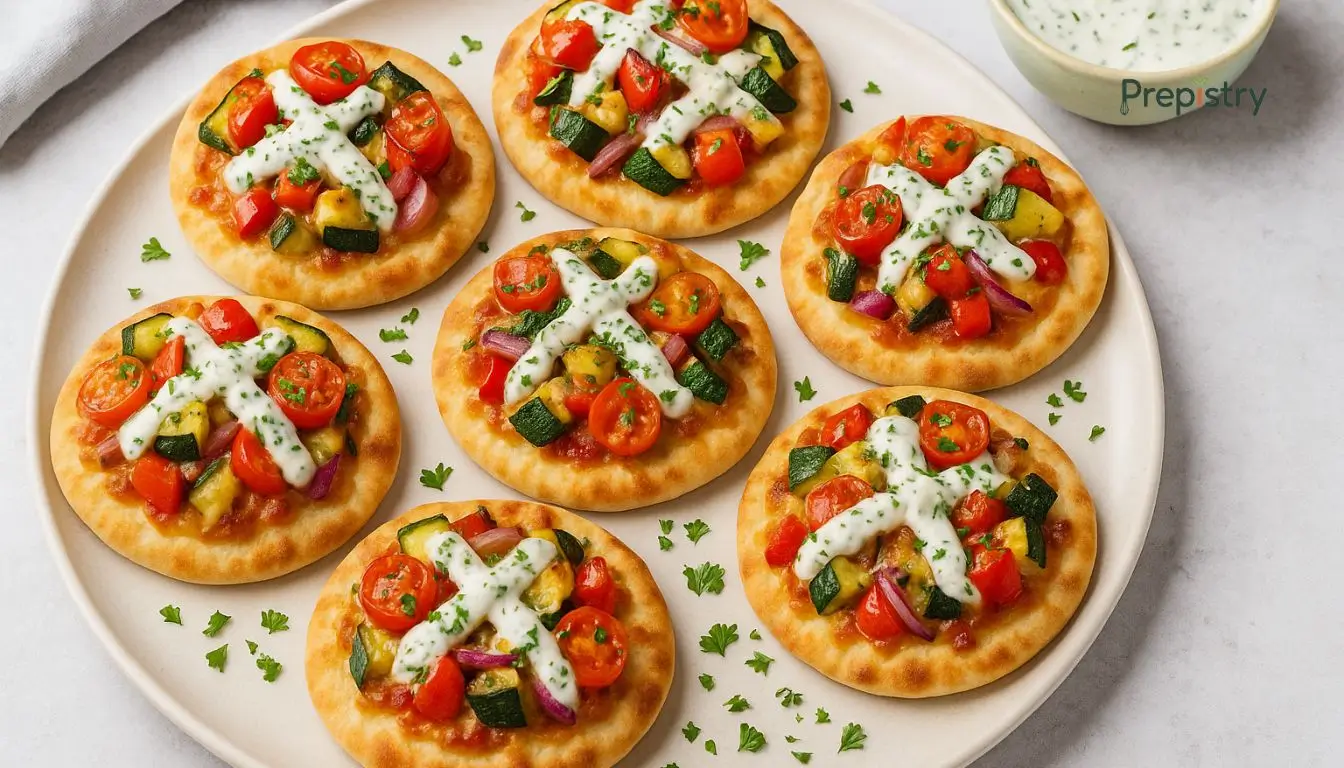
Nutrition Information
Equipment Needed
- Baking sheet
- Mixing bowl
- Knife
- Cutting board
- Spoon
Ingredients
-
4 mini whole wheat pitas
-
1 cup cherry tomatoes, halved
-
1/2 cup sliced black olives
-
1/2 cup diced bell peppers (red, yellow, or green)
-
1/4 cup thinly sliced red onion
-
1/2 cup shredded mozzarella cheese
-
1/2 cup plain Greek yogurt
-
1 tablespoon chopped fresh dill
-
1 tablespoon chopped fresh parsley
-
1 teaspoon lemon juice
-
Salt and pepper to taste
-
1 tablespoon olive oil
Instructions
Recipe Video
Mini Veggie Pita Pizzas with Herbed Yogurt Drizzle
Learn how to make delicious mini veggie pita pizzas topped with a refreshing herbed yogurt drizzle. Perfect for a quick and healthy meal!


